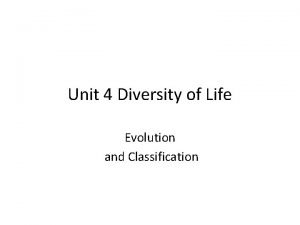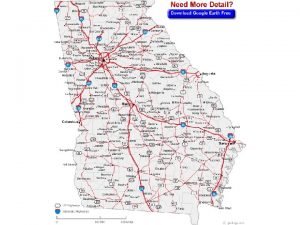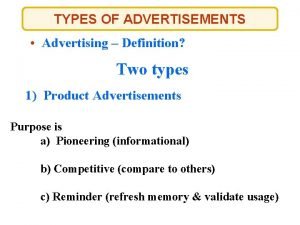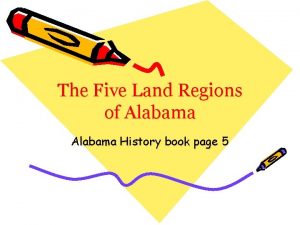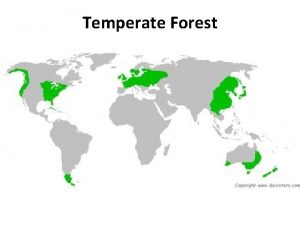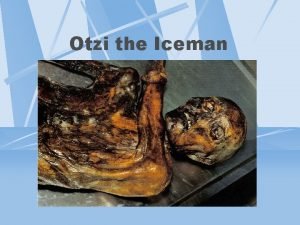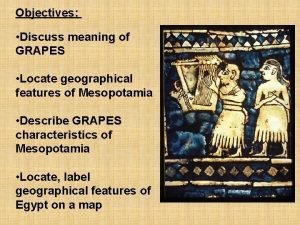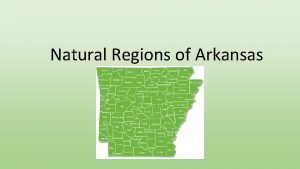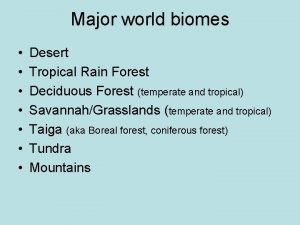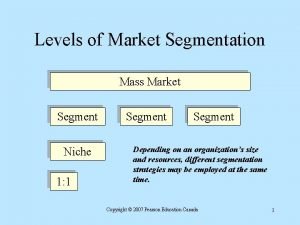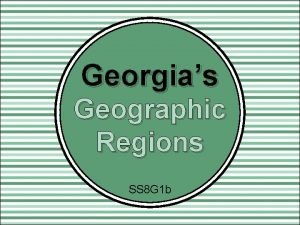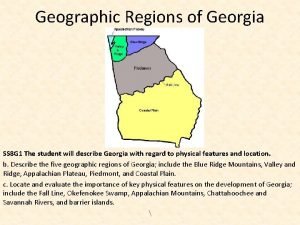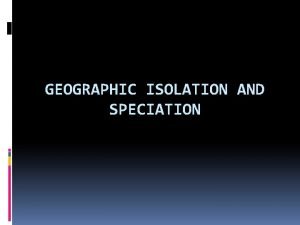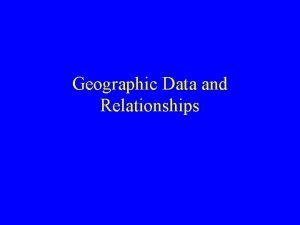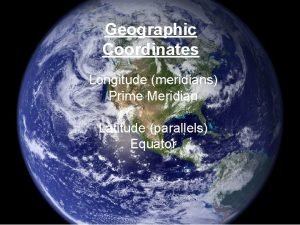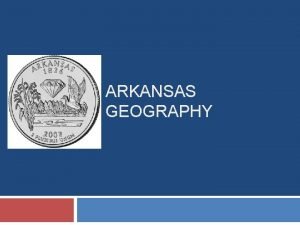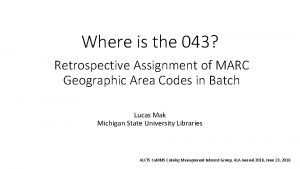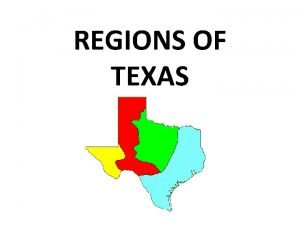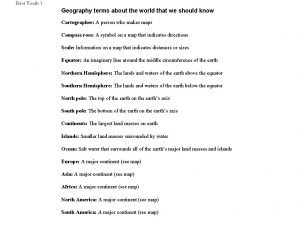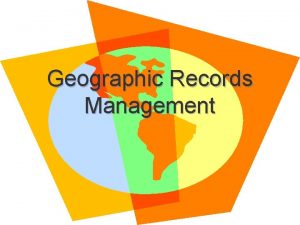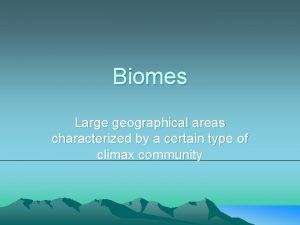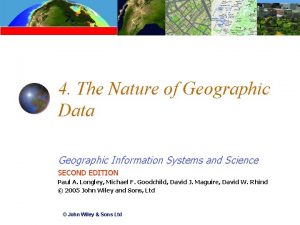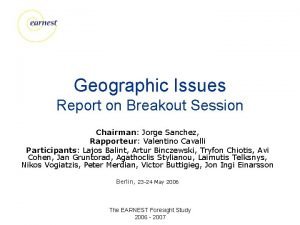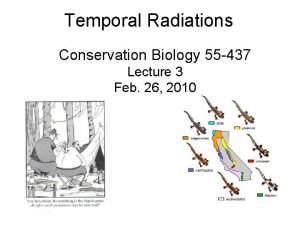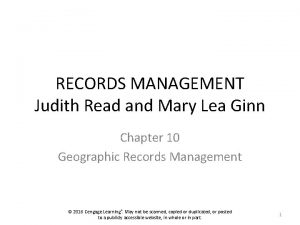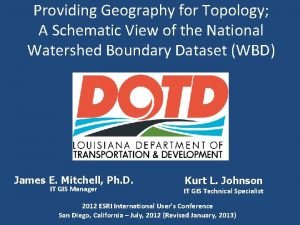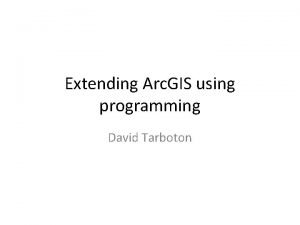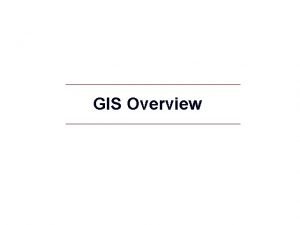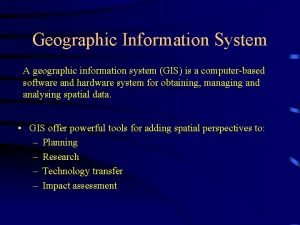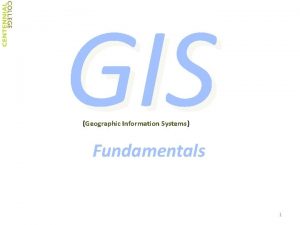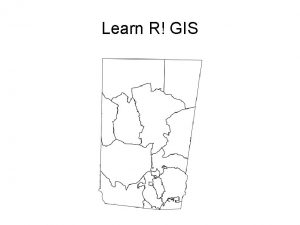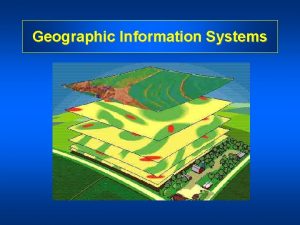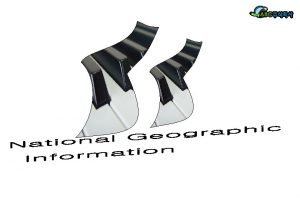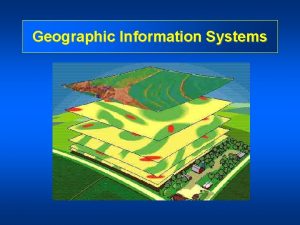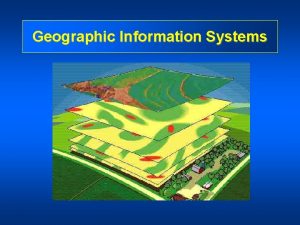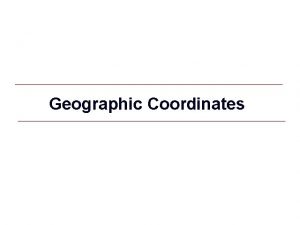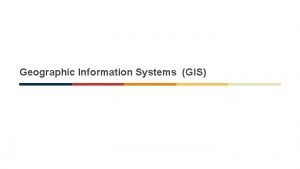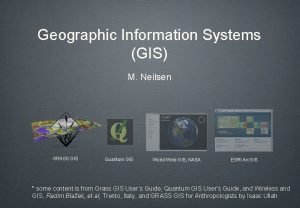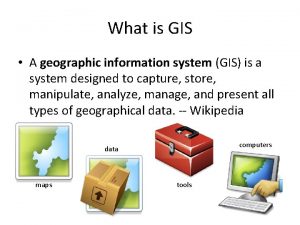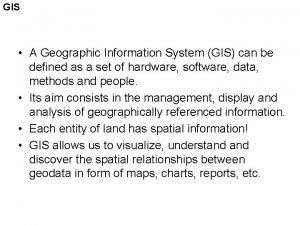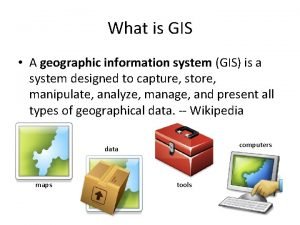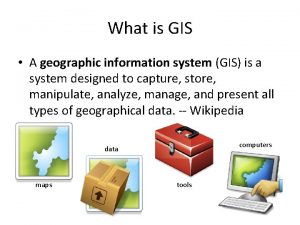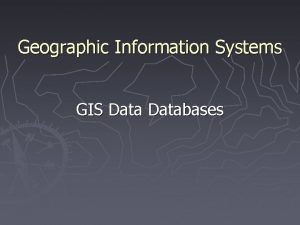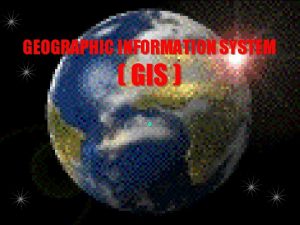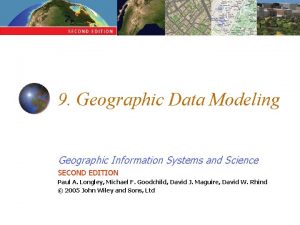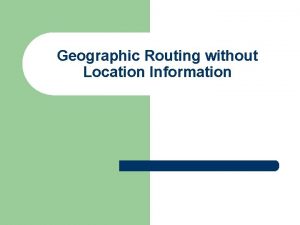GIS Overview What is GIS GIS Geographic Information
























































- Slides: 56

GIS Overview

What is GIS? GIS (Geographic Information System): computer information system that can input, store, manipulate, analyze, and display geographically referenced (spatial) data to support decision making processes.

Tools for a GIS • Hardware - Computer - Printer / Plotter - Digitizer - Scanner • GIS Desktop Software (ESRI, Inc. – Arc. View) • CAD Software (Auto. Desk - Auto. CAD) • Multimedia (Photos, Video, 3 D Models) • World Wide Web (ESRI, Inc. – ARCIMS) • Personnel

GIS Data Sources Digitized and Scanned Maps • purchased, donated, free (Internet) • created by user Data Bases – Tables of data GPS – Global Positioning System • accurate locations Field Sampling of Attributes Remote Sensing & Aerial Photography

Conventional Information Systems • Answer the following questions: - Who ? - What ? - When ? - Why ? - How ?

GIS answers the following • Location: What is at. . . ? • Condition: Where is it? • Trends: What has changed since. . . ? • Patterns: What spatial patterns exist? • Modeling: What if…? Exploring data using GIS turns data into information into knowledge

Data • Location Data How Many? – What Kind? – Where? • Scale of Data Global to Local • Data Presentation Words, Charts, Graphs, Tables, Maps, Photos

Databases • Not easy to interpret

Visualizing Data A picture is worth a thousand words

GIS Data Raster Images - grids • “pixels” • a location and value • satellite images and aerial photos Vector - grids • Features: points, lines & polygons • Attributes: size, type, length, etc.

“Layers” of GIS Information Municipalities

“Layers” of GIS Information Census Tracts

“Layers” of GIS Information Lakes and Rivers

“Layers” of GIS Information Polluting Companies

“Layers” of GIS Information Schools

Maps and Databases are Interactive

GIS Connects Graphics to Data

Maps and Databases are Interactive

Queries and Restrictions

GIS Turns Data into Information A picture is worth a thousand words

GIS Analyzes Information

GIS Examples

World and Country Level




State Level





Township Level






Conclusions State level analysis results indicated Transylvania County as the high risk area in terms of number of children per each HSDS, County level analysis results indicated Brevard Township as the high risk area in terms of combined effect of young population density and HSDS density, Township level analysis results indicated • 4 different HSDS located at the southern region of Brevard Township as potential risk-producing areas, • 2 public schools within 10 minute walking distance buffer of previously detected HSDS, • 4 public water supply sources (PWSS) two of which may supply water to public schools and daycare centers, • A total of 2, 593 people living within 10 minute walking distance of specified HSDS, and total of 506 people (between the ages of 0 and 17) within the same distance.

Obesity Research Objectives • To evaluate if the degree of pediatric obesity, assessed by • BMI Z scores, is related to proximity to fast food restaurants or distance from parks. To determine if the effectiveness of treatment of obesity is related to the following: age, gender, race/ethnicity, number of follow up visits, and proximity to the treatment center. Design/Methods • Patient addresses (n=1, 014) were mapped with GIS, and • then overlaid with parks, fast food locations, and additional layers including socioeconomic, political, school, and neighborhood districts. Distance buffers from the WMWC were created and overlaid with patient addresses and BMI Z score changes following treatment.

Results Proximity to the center was unrelated to success in BMI decreases Travel Distances : Z Score Change (-. 5 to -2. 16), Total 38 Travel Distances: Z Score Change (. 5 to 2. 81) Total 8

Results • Of patients with moderate BMI decrease (Z score change > -0. 5), 43. 7% live within 600 feet of a park and 56. 3% farther than 1200 feet. Mean distance to fast food is 1. 1 miles. • Of patients with moderate BMI increases (Z score change > 0. 5), 16. 7% live within 600 feet of a park and 83. 3% farther than 1200 feet. Mean distance from fast food is. 8 miles. Patient Locations Compared to Fast Food and Parks

Property Value and Street Trees An Analysis of the City of Pittsburgh Neighborhoods, 2009

City of Pittsburgh Neighborhoods Residential Sales, 2009 Average Sale Price by Neighborhood Note: white areas indicate no sales Source: Allegheny County

City of Pittsburgh Neighborhoods and Street Trees, 2009 Number of Trees per Neighborhood Source: Friends of the Pittsburgh Urban Forest

Property Sales Compared to Number of Trees per Block

A “High Risk” Poverty Index Geospatial Analysis Methods for the Greater Pittsburgh Community Food Bank Heinz College: School of Public Policy & Management Brandon C. Loughery, MAM Kristen Kurland, Faculty Advisor Larry Hokaj, Chief Technology Officer GPCFM Spring 2009

Introduction There are three project objectives: • Provide background information to use additional geospatial information systems (GIS) technology for evaluation and predictive processes • Gain a more thorough understanding of the communities GPCFB serves. • Create and implement a delimited index to help identify populations that need the Food Bank’s services the most.

Poverty Variables • Householders in renter-occupied housing with income below the poverty level who receive public assistance income • Total number of the youth population 18 years and younger, by block group, who live at or below the poverty line • Total number of elderly population 65 years and older, by block group, who live at or below the poverty line • Total number of families, by block group, who have a female household head (no husband present) with related children under 18 years of age • The number of elderly population 65 years and older with income below the poverty level and a disability • Total number of families who have a female household head (no husband present) where the household head worked full-time, year round in 1999 and lived below the poverty level • The total number of adults over the age of 18 with no high school diploma *The variables are taken directly from the Sample File 3 (SF 3) sample population data from the U. S. Census.

“High Risk” Poverty Areas Contour Line ≥ 9 Low Risk Medium Risk High Risk

GPCFB Program Locations and High Risk Poverty Areas Low Risk Medium Risk High Risk

FIGURE 3 Buffer Zone around “High Risk” Poverty Areas 1, 500’ Buffer Zone Low Risk Medium Risk High Risk

TABLE 1: Total “High Risk” GPCFB Member Agencies (Raster Value of 12)

TABLE 2: Total “Low Risk” GPCFB Member Agency (Raster Value of 1)

TABLE 3: Variable Data Summary Risk Factor Householders in renter-occupied housing with income below the poverty level who receive public assistance income Total number of the youth population 18 years and younger, by block group, who live at or below the poverty line Total number of elderly population 65 years and older, by block group, who live at or below the poverty line Total number of families, by block group, who have a female household head (no husband present) with related children under 18 years of age The number of elderly population 65 years and older with income below the poverty level and a disability Total number of families who have a female household head (no husband present) where the household head worked fulltime, year round in 1999 and lived below the poverty level The total number of adults over the age of 18 with no high school diploma Sum Mean Standard Deviation 4, 329 23. 92 34. 53 81, 713 200. 28 141. 32 65, 843 161. 38 100. 16 7558 18. 52 39. 15 4, 590 25. 36 23. 53 886 4. 90 9. 19 47, 533 262. 61 197. 90

High Risk Poverty Index Results by Neighborhood

ESRI To learn more, visit: http: //www. esri. com/industries. html
 In a global information system (gis), high coordination:
In a global information system (gis), high coordination: Geographic coordinate system
Geographic coordinate system Weathering national geographic
Weathering national geographic Binomial nomenclature
Binomial nomenclature Ga geographic regions
Ga geographic regions Cooperative advertising definition
Cooperative advertising definition Five regions of alabama
Five regions of alabama Temperate forest geography
Temperate forest geography Geographic terms jeopardy
Geographic terms jeopardy National geographic salem witch trials
National geographic salem witch trials Autzi ecommerce
Autzi ecommerce Nile river clipart
Nile river clipart Regions of arkansas
Regions of arkansas National geographic
National geographic Market segmentation geographic demographic psychographic
Market segmentation geographic demographic psychographic Taiga vs temperate forest
Taiga vs temperate forest Market segmentation levels
Market segmentation levels Geographic luck
Geographic luck Georgia's 5 geographic regions
Georgia's 5 geographic regions Geographic regions of georgia
Geographic regions of georgia Which of georgia's geographic regions is the smallest?
Which of georgia's geographic regions is the smallest? What is geographic isolation
What is geographic isolation Types of geographic data
Types of geographic data How latitude is measured
How latitude is measured Geographic distribution of species evolution
Geographic distribution of species evolution Geographic regions of arkansas
Geographic regions of arkansas National geographic alliance
National geographic alliance Geographic features of greece
Geographic features of greece Marc 043
Marc 043 4 texas regions
4 texas regions General alphabetic section of the numeric file
General alphabetic section of the numeric file World geography terms
World geography terms Geographic records management
Geographic records management Geographic features of australia
Geographic features of australia South carolina geographic regions
South carolina geographic regions National geographic camel photo
National geographic camel photo A large geographic area characterized
A large geographic area characterized National geographic photo of the year
National geographic photo of the year Ecological globalization
Ecological globalization Nature of geographic data
Nature of geographic data The geographic feature most responsible for extensive trade
The geographic feature most responsible for extensive trade Pros and cons of geographic segmentation
Pros and cons of geographic segmentation Nature of geographical data
Nature of geographical data Coordinate that specifies the north-south position
Coordinate that specifies the north-south position Breakout national geographic
Breakout national geographic What is a geographical event
What is a geographical event Frilled shark national geographic
Frilled shark national geographic Lingua franca definition ap human geography
Lingua franca definition ap human geography National geographic
National geographic Geospiza
Geospiza Records management mary l. ginn
Records management mary l. ginn Geographic view
Geographic view Geographic literacy survey
Geographic literacy survey Geographic in business plan
Geographic in business plan Geographic map
Geographic map Geographic view
Geographic view Managing brands over geographic boundaries
Managing brands over geographic boundaries



